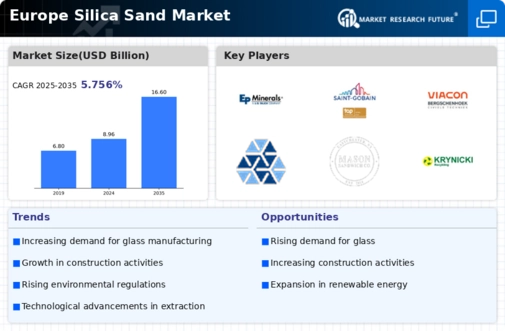The Europe Silica Sand Market is characterized by its diverse range of applications across various industries, including construction, glass manufacturing, and hydraulic fracturing, which has led to intensified competition among key players seeking to establish a stronger foothold in the region. The market dynamics are influenced by various factors, such as the growing demand for high-purity silica sand, an increase in infrastructure development, and strict regulations governing product quality and environmental impacts.
In this competitive landscape, companies are focusing on innovation, optimization of their supply chains, and strategic partnerships to enhance their presence in the European market while continually adapting to evolving customer needs and industry standards. The holistic competitive environment demands a gauging of market share distribution, pricing strategies, and the ability to meet sustainability practices that resonate with modern consumers.Mernok Trade has built a reputation as a prominent player in the Europe Silica Sand Market, focusing on the provision of high-quality products aimed at various applications.
The company has established a broad customer base across the continent, leveraging its strategic positioning to enhance its operational capabilities. Mernok Trade stands out for its efficient supply chain management, which enhances timely delivery and responsiveness to customer demands, contributing to sustained customer loyalty. The company has also prioritized quality control processes, ensuring that its silica sand products meet industry standards and meet customer expectations.
Through a concentrated approach to market expansion, Mernok Trade has successfully garnered a strong market presence, strengthening its competitive edge within the region.EP Minerals holds a significant position in the Europe Silica Sand Market, mainly due to its focus on providing innovative solutions tailored to specific industry requirements. The company specializes in lightweight silica products, which are increasingly utilized within the construction and environmental sectors. EP Minerals capitalizes on a solid reputation for product quality, offering high-performance silica sand that caters to a variety of applications.
With strategic mergers and acquisitions in recent years, the company has enhanced its production capabilities and broadened its product portfolio, allowing it to cater to diverse market segments effectively. This integration has further bolstered EP Minerals' competitive advantage by providing greater economies of scale and a more extensive distribution network. In working to address the growing environmental concerns, EP Minerals focuses on sustainability, aiming for rechargeable and recyclable options within its offerings while positioning itself as a responsible player within the European market.

















